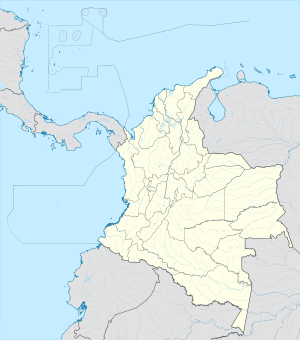
The Revolutionary Armed Forces of Colombia – People's Army is a Marxist–Leninist guerrilla group involved in the continuing Colombian conflict starting in 1964. The FARC-EP was officially founded in 1966 from peasant self-defense groups formed from 1948 during La Violencia as a peasant force promoting a political line of agrarianism and anti-imperialism. They are known to employ a variety of military tactics, in addition to more unconventional methods, including terrorism.

A car bomb, bus bomb, van bomb, lorry bomb, or truck bomb, also known as a vehicle-borne improvised explosive device (VBIED), is an improvised explosive device designed to be detonated in an automobile or other vehicles.

The Bojinka plot was a large-scale, three-phase terrorist attack planned by Ramzi Yousef and Khalid Sheikh Mohammed for January 1995. They planned to assassinate Pope John Paul II; blow up 11 airliners in flight from Asia to the United States, with the goal of killing approximately 4,000 passengers and shutting down air travel around the world; and crash a plane into the headquarters of the United States Central Intelligence Agency (CIA) in Langley, Virginia.
In June 2000, the North Caucasian Chechen separatist-led Chechen insurgents added suicide bombing to their tactics in their struggle against Russia. Since then, there have been dozens of suicide attacks within and outside the republic of Chechnya, resulting in thousands of casualties among Russian security personnel and civilians. The profiles of the suicide bombers have varied, as have the circumstances surrounding the bombings.

The 2003 El Nogal Club bombing was a terrorist attack that occurred in Bogotá, Colombia. On 7 February 2003, a car containing 200 kg of explosives that was parked in a garage on the third floor of the multi-story El Nogal club, an elite, high-class social and business club, exploded, killing 36 people and wounding more than 200. There were approximately 600 people in the building at the time of the explosion. The attack was the worst in Colombia for more than a decade.

Víctor Julio Suárez Rojas — a.k.a. Jorge Briceño Suárez a.k.a. Mono Jojoy — was a high-ranking member of the Revolutionary Armed Forces of Colombia (FARC), a Colombian guerrilla organization. He was second-in-command to Alfonso Cano and top military commander. Suárez Rojas commanded the Eastern Bloc of the FARC and was a member of the FARC Secretariat. His nom de guerre was Jorge Briceño Suárez; to the Colombian army he was known as Mono Jojoy.
Numerous civilians, including men, women, children, government officials, activists, secular intellectuals and clerics have been victims of assassination, terrorism, or violence against non-combatants, over the course of modern Iranian history. Among the most notable acts of terrorism in Iran in the 20th century have been the 1978 Cinema Rex fire and the 1990s chain murders of Iran.
The following is a list of attacks which have been carried out by Al-Qaeda.
The 2007 Casablanca bombings refer to a series of suicide bombings in March and April 2007 in Casablanca, Morocco.

The 2012 Bangkok bombings were a series of explosions that occurred in Bangkok, Thailand on 14 February 2012, injuring five people. Thai authorities said that the bombings were a botched attempt by Iranian nationals to assassinate Israeli diplomats. Several Iranians were arrested and charged for the attacks, one of whom was badly injured.
Terrorism in Colombia has occurred repeatedly during the last several decades, largely due to the ongoing armed conflict the country has been involved in since 1964. Perpetrators of terrorist acts in the country range from leftist guerrilla forces including FARC, ELN and M-19, to drug cartels such as the Medellín Cartel, to right-wing paramilitary forces including the AUC.
Terrorism in Ecuador is a rare occurrence as the country, despite recurrent periods of economic and political instability, has been traditionally known as a peaceful state in Latin America, unlike its neighbor states; Peru and Colombia, which have suffered widespread violence by insurgent, paramilitary and drug trafficking organizations in different degrees for more than fifty years.

This is a 2018 timeline of events in the Somali Civil War (2009–present).

The 2002 Lima bombing was a car bomb attack in Lima, Peru that occurred at El Polo Shopping Centre, just outside the embassy of the United States, killing nine people and injuring thirty-two. The blast came just three days prior to a visit to Peru from the United States President George W. Bush. No Americans were caught in the explosion. An estimated 30 kilograms (66 lb) of explosives was used in the attack.
On 17 January 2019, a vehicle was driven into the General Santander National Police Academy in Bogotá, Colombia. The truck forced its way into the facility, hit a wall and detonated, killing 22 people and injuring 68 others. Suicide attacks are unusual in Colombia. The car contained about 80 kilograms (180 lb) of pentolite. It was the deadliest attack on the Colombian capital since the 2003 El Nogal Club bombing and the first terrorist attack on the capital since the 2017 Centro Andino bombing. The National Liberation Army (ELN) accepted responsibility for the attack and justified it as a response to the bombings made by the Colombian government during the unilateral ceasefire.
On 2 September 2022, a police vehicle hit a bomb near the town of Corozal, killing seven police officers and injuring another.
Events from the year 2003 in Colombia.








